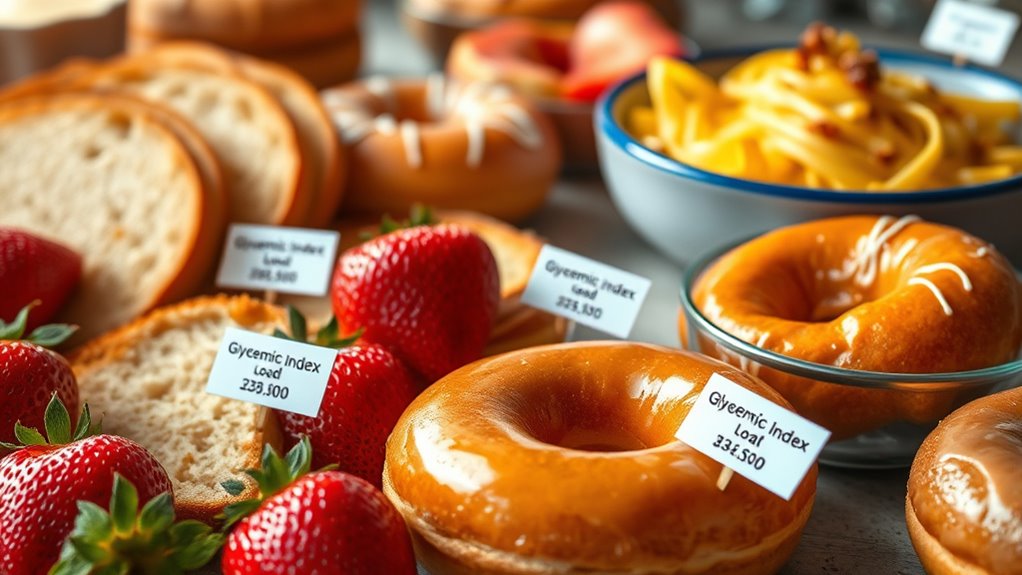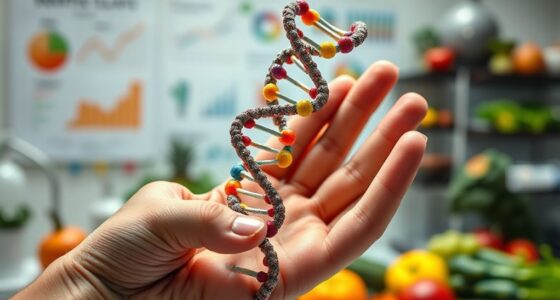Glycemic Index (GI) measures how quickly carbs in food raise your blood sugar, while Glycemic Load (GL) considers both the GI and portion size for a more practical impact. GI focuses on speed, but GL shows the real effect based on how much you eat. Eating high-GI foods might spike your blood sugar, but paying attention to GL helps you control those fluctuations more effectively. Keep exploring to learn more ways to manage your carbohydrate intake!
Key Takeaways
- Glycemic Index (GI) measures how quickly a carbohydrate-containing food raises blood sugar, regardless of portion size.
- Glycemic Load (GL) considers both the GI and the carbohydrate amount in a typical serving for real-world blood sugar impact.
- GI focuses on carbohydrate quality, while GL combines quality and quantity to assess overall effect.
- Portion control significantly influences GL, as large servings can cause spikes even with low-GI foods.
- Using both GI and GL helps make informed food choices for better blood sugar management and overall health.
What Is the Glycemic Index and How Is It Calculated?
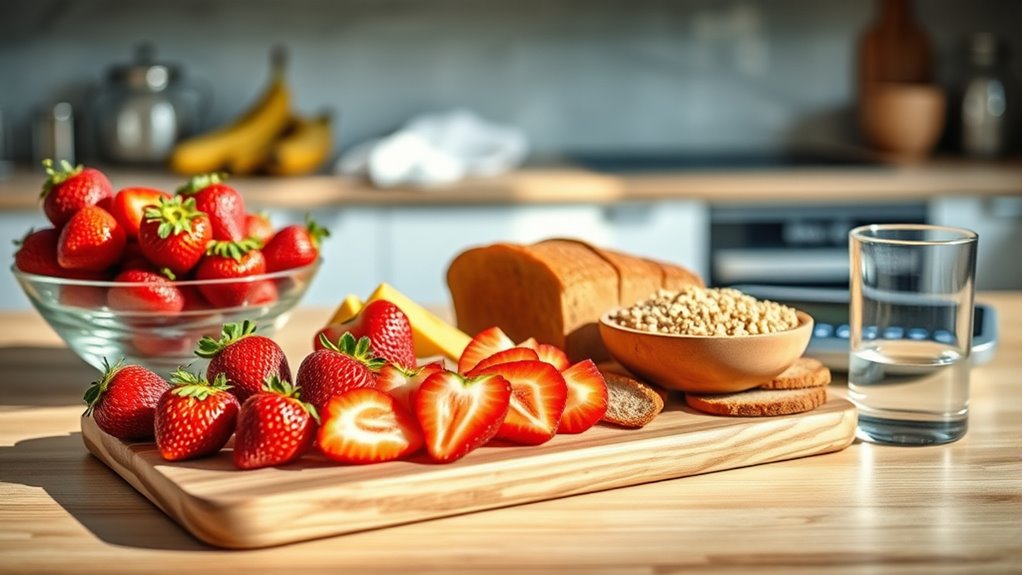
The glycemic index (GI) measures how quickly a carbohydrate-containing food raises your blood sugar levels after eating. It’s influenced by factors like fiber content, which can slow digestion and reduce the GI. Foods high in fiber tend to have a lower GI, helping you manage blood sugar spikes. Portion control also plays a role; eating large servings of high-GI foods can cause bigger increases in blood sugar, regardless of the food’s inherent GI. To use GI effectively, focus on smaller portions of higher-GI foods and incorporate more fiber-rich options into your meals. This approach helps you balance blood sugar levels and avoid rapid spikes, promoting better overall health. Remember, GI is just one piece of the puzzle in managing carbohydrate impact. Incorporating natural materials like wood and linen can also support a balanced approach to health by creating a calming environment that encourages mindful eating. Additionally, understanding the role of fiber content can further aid in selecting foods that moderate blood glucose responses.
Understanding Glycemic Load and Its Significance
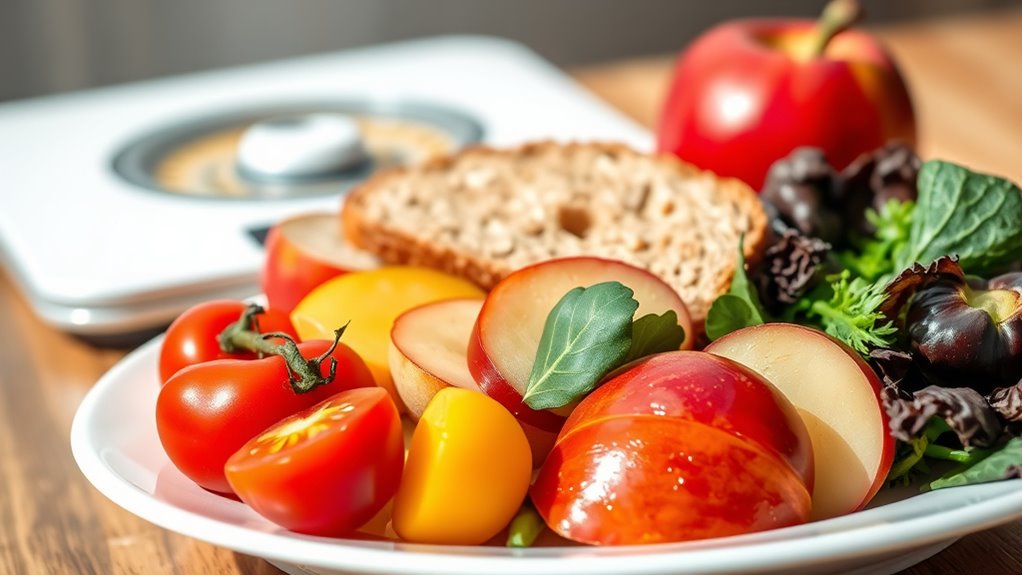
Glycemic load (GL) provides a more extensive picture of how a food affects your blood sugar than glycemic index alone. It considers both the carbohydrate quantity and quality, making it useful for managing blood sugar levels. GL highlights the importance of fiber benefits, as higher fiber foods tend to have lower loads, stabilizing your blood sugar. Additionally, carbohydrate timing plays a crucial role; eating foods with a lower GL at strategic times can prevent spikes and crashes. Understanding carbohydrate quality can further enhance meal planning and blood sugar control. Recognizing the types of carbohydrates and their effects can help tailor a dietary approach that supports metabolic health. Here’s a quick comparison: IRA investment strategies can be optimized by understanding how different foods impact blood sugar levels over time.
| Glycemic Load (GL) | Significance |
|---|---|
| Considers carbohydrate quantity | Better reflects real-world food impact |
| Incorporates fiber benefits | Helps control blood sugar fluctuations |
| Emphasizes carbohydrate timing | Guides meal planning for stability |
| Useful for managing health | Especially for diabetics and athletes |
The Differences Between Glycemic Index and Glycemic Load
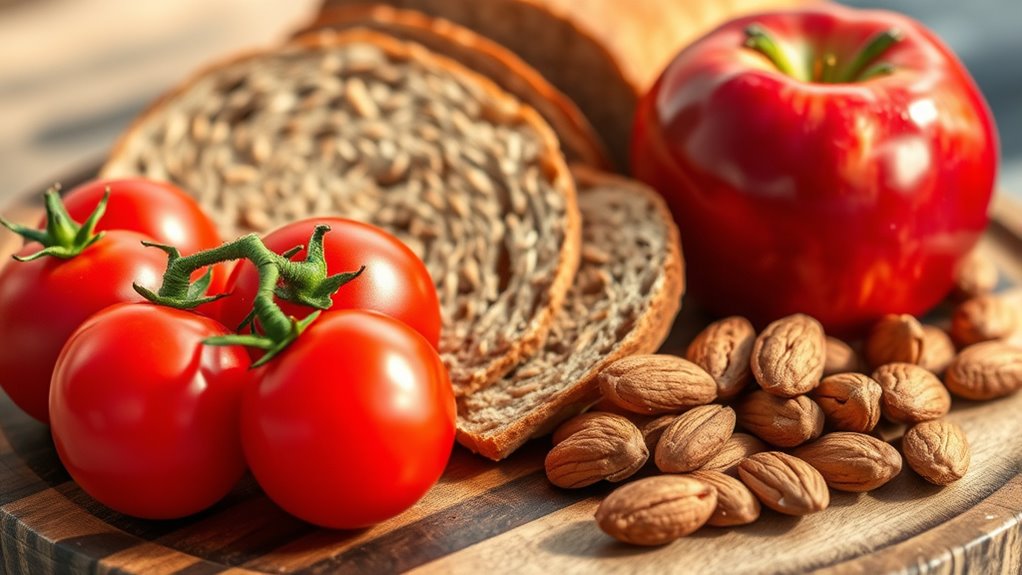
While glycemic index and glycemic load are related concepts, they serve different purposes in understanding how foods impact blood sugar. The glycemic index measures how quickly a carbohydrate-containing food raises blood sugar levels, regardless of portion size. In contrast, glycemic load considers both the glycemic index and the portion size, giving a more practical picture of a food’s actual impact. Fiber content plays a role because higher fiber foods tend to have lower GI and GL scores, slowing sugar absorption. Portion control is essential with glycemic load because eating large servings of even low-GI foods can spike blood sugar. Additionally, sugar absorption can be influenced by other factors such as food preparation methods and food combinations. Knowing these differences helps you make more informed choices, balancing carbohydrate quality with quantity for better blood sugar management. Understanding the differences between GI and GL can help tailor your diet to maintain more stable energy levels throughout the day.
How Carbohydrates Affect Blood Sugar Levels
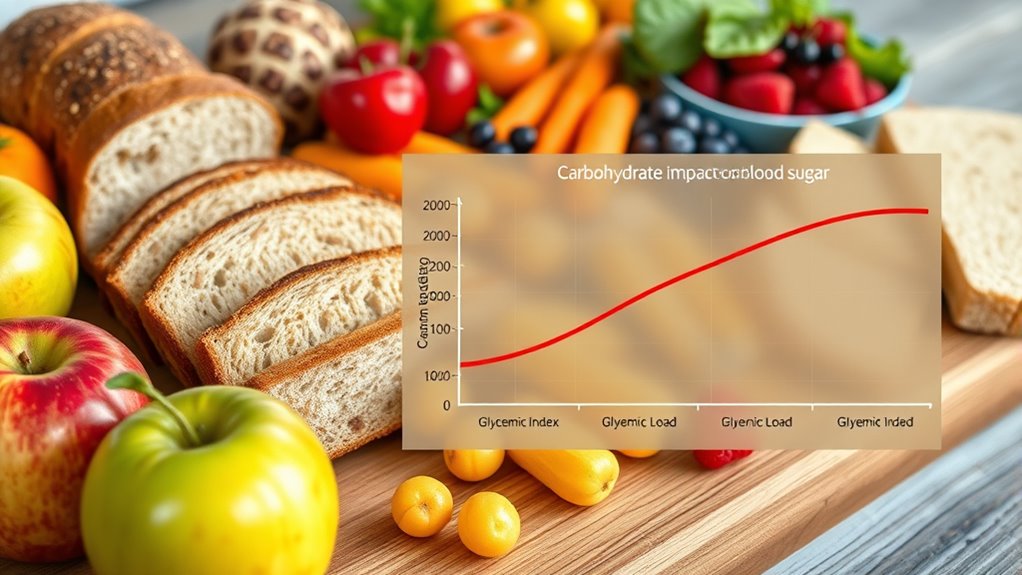
Carbohydrates are the primary nutrients that directly impact your blood sugar levels because they are broken down into glucose during digestion. How your body responds depends on factors like fiber content and portion control. To manage this effect, consider these points: 1. High fiber content slows digestion, leading to a gradual rise in blood sugar. 2. Carbohydrate quantity influences blood sugar spikes; larger portions cause bigger increases. 3. Combining carbs with protein or fat can stabilize blood sugar levels. 4. Portion control helps prevent excessive glucose absorption, reducing the risk of sharp blood sugar spikes. Additionally, choosing glycolic acid products can improve skin texture and pore appearance, supporting overall skin health. Understanding the glycemic index and load can further help you make informed dietary choices for blood sugar management.
Practical Examples of High and Low GI Foods
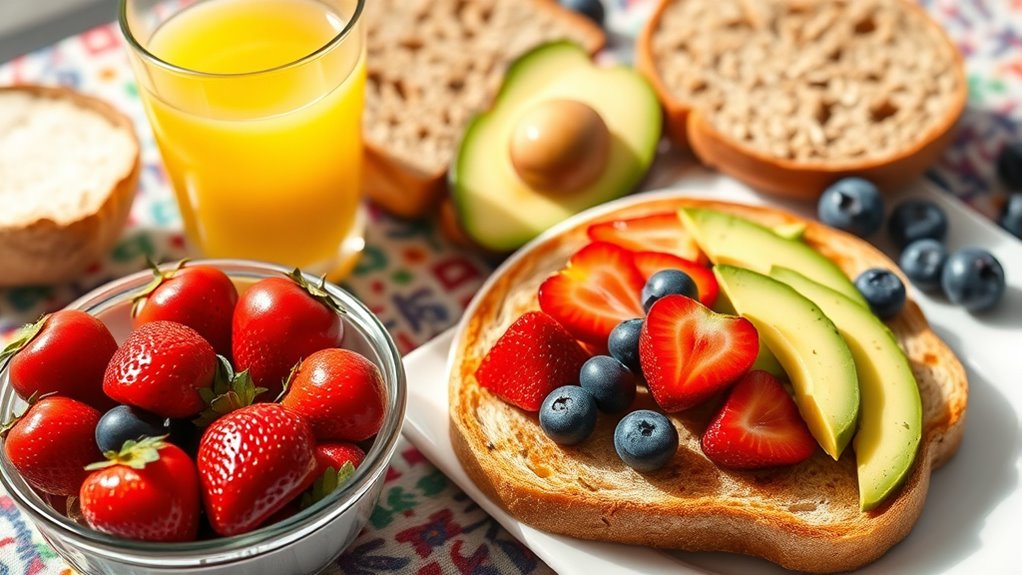
You can easily spot high GI foods like white bread and sugary snacks, which cause quick blood sugar spikes. Low GI options such as whole grains and legumes help keep your levels steady. Incorporating practical meal tips can make balancing these choices simpler and more effective.
High GI Food Examples
High glycemic index (GI) foods cause rapid spikes in blood sugar levels, making them important to recognize for managing blood glucose. Common examples include:
- White bread – low fiber content and easy to overconsume, so watch portion control.
- Sugar-sweetened beverages – high in simple carbs, leading to quick blood sugar rises.
- Potatoes – especially mashed or processed varieties, which have high GI scores.
- Rice (white) – rapid digestibility, with portion control being key to avoid spikes.
To manage these foods, focus on increasing fiber content and practicing portion control. Choosing whole grains or pairing high GI foods with fiber-rich vegetables helps slow digestion and stabilize blood sugar levels.
Low GI Food Examples
While high GI foods can cause rapid blood sugar spikes, low GI foods help maintain steady levels and support better blood glucose control. Examples include fiber-rich foods like legumes, lentils, and most vegetables, which slow digestion and glucose absorption. Whole grains such as oats, barley, and brown rice are also low GI options, fitting well into a Mediterranean diet focused on healthy fats, lean proteins, and plant-based foods. Fruits like berries, cherries, and apples tend to have lower GI values compared to tropical fruits. Incorporating these foods into your meals helps stabilize blood sugar and promotes sustained energy. Additionally, Best Beaches offer relaxing environments that can help reduce stress, which is beneficial for blood sugar management. Choosing low GI foods that are rich in fiber and nutrients can further enhance your blood sugar control and overall health. Consuming foods with a low glycemic load can provide a more accurate picture of how foods impact blood sugar levels after eating. By choosing these foods into your diet, you support overall health and better manage blood glucose levels over time.
Practical Meal Tips
To effectively manage your blood sugar levels, incorporating practical meal tips can make a significant difference. Focus on choosing foods with high fiber content, which helps slow digestion and stabilize blood sugar. Portion control also plays a vital role; eating smaller, balanced servings prevents spikes. Here are some tips:
- Select whole grains like oats or quinoa instead of refined grains.
- Pair carbohydrate-rich foods with protein or healthy fats to reduce glycemic response.
- Incorporate plenty of vegetables, which are low GI and high in fiber.
- Use smaller plates and measure servings to maintain portion control.
- Understanding the glycemic index and load of foods can help you make informed choices for blood sugar management. Additionally, being aware of carbohydrate impact can guide healthier eating habits.
These strategies help you enjoy a variety of foods while keeping your blood sugar steady and supporting overall health.
How to Use GI and GL to Make Better Food Choices
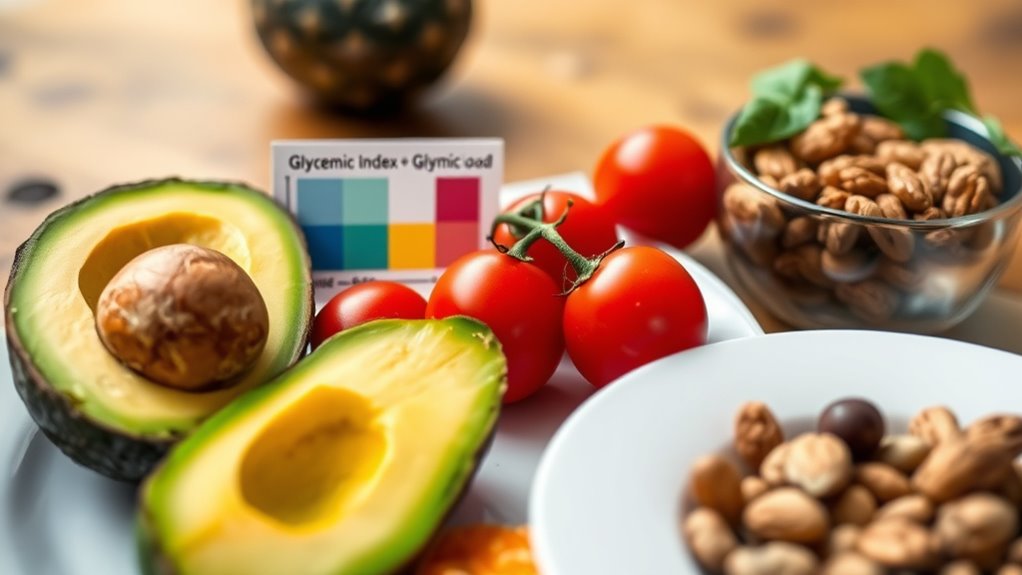
Understanding how to use Glycemic Index (GI) and Glycemic Load (GL) can profoundly improve your food choices and help manage blood sugar levels. Focus on choosing foods with lower GI and GL values to prevent spikes, especially when planning meals. Incorporate fiber benefits by selecting whole grains, vegetables, and fruits, which slow carbohydrate digestion and stabilize blood sugar. Pay attention to carbohydrate timing; spreading carbs evenly throughout the day avoids overload and maintains steady energy. Combine high-GI foods with protein or healthy fats to reduce their impact. Reading labels and understanding portion sizes also helps control GL. Additionally, selecting Essential Oils for Health Conditions such as peppermint or chamomile can support relaxation and overall well-being, complementing dietary efforts. By making mindful choices based on GI and GL, you support better energy levels, weight management, and overall health.
The Impact of Food Preparation and Ripeness on GI and GL

Food preparation methods and the ripeness of produce considerably influence their glycemic index and load. Ripe fruits, for example, tend to have higher GI because their natural sugars are more accessible. Similarly, cooking methods can alter carbohydrate digestibility. Here are four key points:
- Overripe fruits have increased food ripeness, raising their GI and GL.
- Boiling starchy vegetables, like potatoes, increases their GI compared to steaming or baking.
- Crushing or pureeing foods breaks down cell walls, often boosting GI.
- Cooling cooked foods, such as pasta, can lower GI by forming resistant starches.
- The use of aesthetic wall organization systems can help maintain a tidy space that encourages healthy eating habits.
- Proper storage and handling of produce can help preserve their nutritional quality and influence their GI and GL.
Limitations and Criticisms of GI and GL Measures
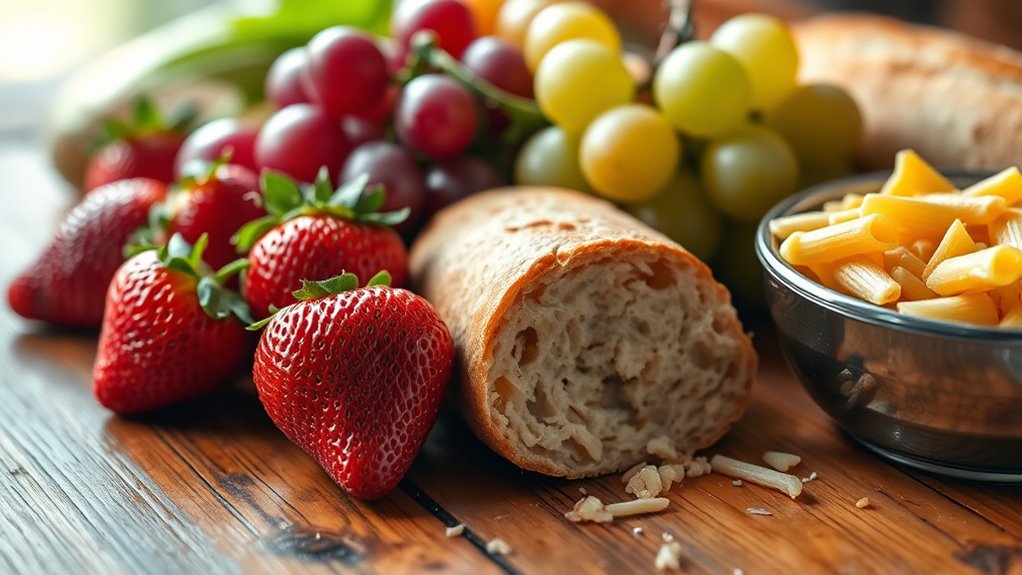
While GI and GL can be helpful tools, they have notable limitations. Variability in testing conditions means results aren’t always consistent, and they often oversimplify complex carbohydrate interactions. You should be aware that these measures don’t capture all factors influencing blood sugar responses.
Variability in Testing
Variability in testing methods poses significant challenges to the reliability of Glycemic Index (GI) and Glycemic Load (GL) measurements. This testing variability affects measurement consistency, making it harder to compare results across studies or foods. Factors influencing variability include:
- Differences in test subjects’ metabolic responses
- Variations in food preparation and portion sizes
- Inconsistent testing protocols and timing
- Diverse laboratory techniques and equipment
These issues can lead to fluctuations in GI and GL values, reducing confidence in their accuracy. As a result, you might find it difficult to rely solely on these measures for dietary decisions. Recognizing this variability highlights the need for standardized testing procedures to improve measurement consistency, ensuring you make well-informed choices based on more dependable data.
Oversimplification of Carbohydrates
Glycemic Index and Glycemic Load simplify complex carbohydrate behaviors into single numerical values, but this approach often overlooks the nuances of how different foods impact blood sugar. You might fall for complex carbohydrate misconceptions, believing all high-GI foods spike blood sugar equally, which isn’t true. These measures offer simplified carbohydrate classifications that ignore factors like fiber, fat, and protein, which can modify a food’s glycemic response. Relying solely on GI or GL can lead you to overlook the overall nutritional quality of foods. Carbohydrate behavior varies based on food processing, ripeness, and combination with other nutrients. Recognizing these limitations helps you avoid oversimplified views, allowing for a more exhaustive understanding of how different foods truly affect your blood sugar levels. Additionally, carbohydrate behavior can be influenced by individual differences in digestion and metabolism, making personalized approaches more effective.
Incorporating GI and GL Into a Balanced Diet
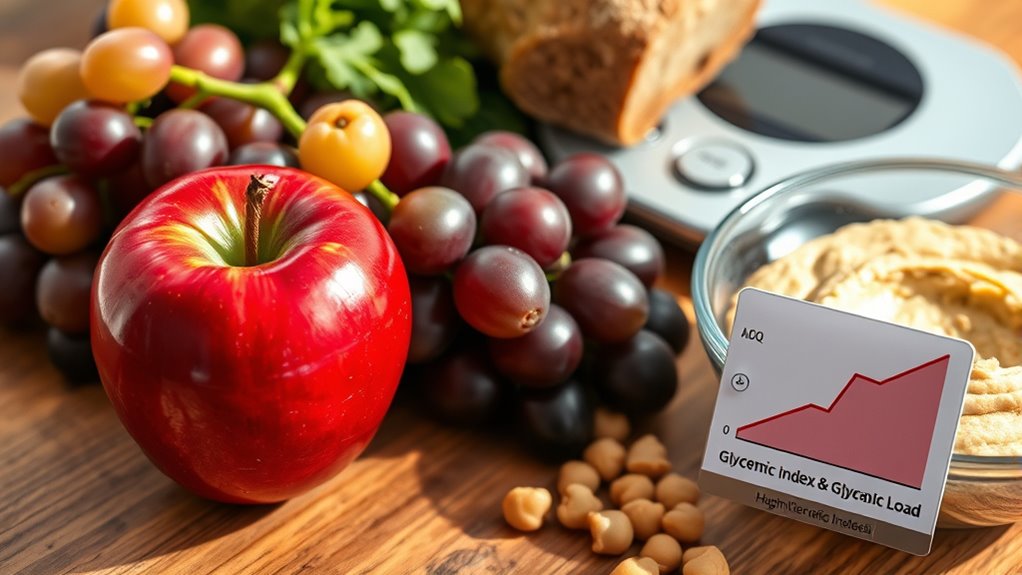
Incorporating glycemic index (GI) and glycemic load (GL) into a balanced diet requires understanding how these measures influence blood sugar levels and overall health. To do this effectively, focus on the following:
- Choose foods high in fiber intake, which helps slow carbohydrate absorption and stabilize blood sugar.
- Practice portion control to prevent spikes, especially with high-GI foods.
- Combine low-GI foods with protein or healthy fats to further regulate blood sugar response.
- Be mindful of meal timing, spreading carbohydrate intake evenly throughout the day.
- Employ mindful decluttering strategies, such as organizing your kitchen and pantry, to better select and prepare foods that support stable blood sugar levels.
Tips for Managing Blood Sugar Using GI and GL Knowledge
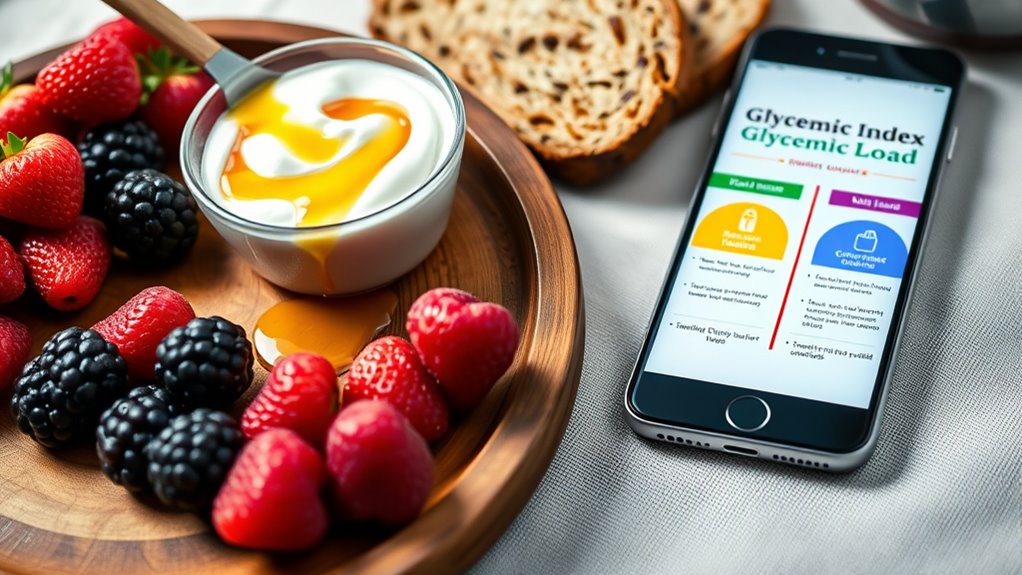
Understanding how GI and GL affect blood sugar levels can help you make smarter food choices throughout the day. To manage your blood sugar effectively, focus on increasing your fiber intake, which slows digestion and stabilizes blood sugar spikes. Incorporate high-fiber foods like vegetables, whole grains, and legumes into your meals. Pay attention to meal timing; eating smaller, balanced meals spaced evenly prevents sharp rises in blood sugar. Combine carbs with protein or healthy fats to further slow digestion. Avoid large, carbohydrate-heavy meals that can cause rapid increases in blood glucose. Staying consistent with your meal schedule and choosing low-GI and low-GL foods can make a significant difference in blood sugar control. These habits support sustained energy and overall health. Additionally, selecting tea accessories like infusers and storage can encourage mindful tea consumption, which is a healthy alternative to sugary beverages. Incorporating hybrid tuning techniques into your diet plan, such as adjusting meal compositions, can further optimize blood sugar management.
Frequently Asked Questions
How Do Diet and Exercise Influence Glycemic Response?
You can influence your glycemic response through diet and exercise by paying attention to carbohydrate timing and meal composition. Eating balanced meals with fiber and protein slows glucose absorption, while spreading carbs evenly throughout the day prevents spikes. Regular exercise enhances insulin sensitivity, helping your body manage blood sugar levels more effectively. Combining mindful carbohydrate choices with consistent physical activity keeps your glycemic response stable and supports overall health.
Are There Individual Differences in Glycemic Index and Load Effects?
You should know that individual differences in glycemic index and load effects exist due to genetic variability and metabolic differences. These factors influence how your body responds to carbohydrate-rich foods, meaning the same food can affect you differently than someone else. Your unique genetics and metabolism determine how quickly your blood sugar rises and falls, so personalized approaches to managing your glycemic response are essential for effective blood sugar control.
Can GI and GL Help Manage Diabetes More Effectively?
While insulin regulation and meal planning are key for managing diabetes, understanding how Glycemic Index (GI) and Glycemic Load (GL) work offers deeper insight. GI measures how quickly carbs raise blood sugar, while GL considers portion size. Using both helps you select foods that stabilize blood sugar, making meal planning more effective. You’re empowered to make smarter choices, balancing immediate energy needs with long-term health goals.
How Reliable Are GI and GL Measurements Across Different Labs?
You might wonder how reliable GI and GL measurements are across different labs. Lab variability can affect measurement consistency, leading to slight differences in results. Factors like testing methods and equipment quality influence accuracy. While GI and GL are useful guides, don’t rely solely on lab results. For best results, use standardized testing methods and compare results over time to get a clearer picture of how foods impact your blood sugar.
Are There Specific Populations That Should Prioritize GI or GL?
Did you know that about 1 in 10 people worldwide has diabetes? If you’re aiming for athletic performance or weight management, you might want to prioritize glycemic load (GL) over glycemic index (GI). GL accounts for carbohydrate quantity, helping you better control blood sugar spikes. People with diabetes, athletes, or those on strict diets should focus on GL to optimize energy and maintain stable blood sugar levels.
Conclusion
By understanding glycemic index and load, you gain tools to better manage your blood sugar. Remember, what seems insignificant—like ripeness or cooking method—can unexpectedly influence your health. Sometimes, it’s the small choices—like choosing a low GI snack—that make a big difference over time. Embrace this knowledge, and you’ll find that even the tiniest adjustments can lead to a healthier, more balanced life, reminding you that awareness often holds the key to lasting change.
